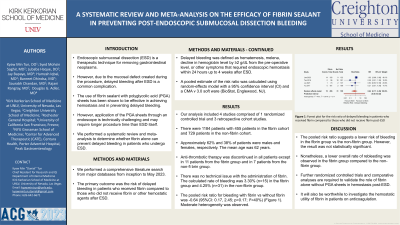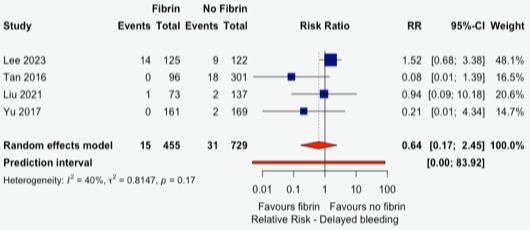Monday Poster Session
Category: GI Bleeding
P2028 - A Systematic Review and Meta-Analysis on the Efficacy of Fibrin Sealant in Preventing Post-Endoscopic Submucosal Dissection Bleeding
Monday, October 23, 2023
10:30 AM - 4:15 PM PT
Location: Exhibit Hall

Has Audio

Kyaw Min Tun, DO
Kirk Kerkorian School of Medicine at UNLV
Las Vegas, NV
Presenting Author(s)
Kyaw Min Tun, DO1, Syed Mohsin Saghir, MD2, Lubaba Haque, DO1, Jay Bapaye, MBBS, MD3, Humzah Iqbal, MD4, Banreet S. Dhindsa, MD5, Saurabh Chandan, MD, MBBS6, Rajani Rangray, MBBS7, Douglas G. Adler, MD8
1Kirk Kerkorian School of Medicine at UNLV, Las Vegas, NV; 2Creighton University, Omaha, NE; 3Rochester General Hospital, Rochester, NY; 4University of California San Francisco, Fresno, Fresno, CA; 5University of Nebraska Medical Center, Omaha, NE; 6Creighton University School of Medicine, Omaha, NE; 7CHI Health Creighton University Medical Center, Omaha, NE; 8Center for Advanced Therapeutic (CATE), Centura Health, Porter Adventist Hospital, Peak Gastroenterology, Denver, CO
Introduction: Endoscopic submucosal dissection (ESD) is a therapeutic technique for removing gastrointestinal neoplasms. However, due to the mucosal defect created during the procedure, delayed bleeding after ESD is a common complication. The use of fibrin sealant with polyglycolic acid (PGA) sheets is effective in achieving hemostasis and in preventing delayed bleeding. However, application of the PGA sheets through an endoscope is technically challenging and may require longer procedure time than ESD itself. We performed a systematic review and meta-analysis to determine whether fibrin alone can prevent delayed bleeding in patients who undergo ESD.
Methods: We performed a comprehensive literature search from major databases from inception to May 2023. The primary outcome was the risk of delayed bleeding in patients who received fibrin compared to those who did not receive fibrin or other hemostatic agents after ESD. Delayed bleeding was defined as hematemesis, melena, decline in hemoglobin level by ≥2 g/dL from the preoperative level, or other symptoms that required endoscopic hemostasis between 24 hours to 4 weeks after ESD. A pooled estimate of the risk ratio was calculated using random-effects model with a 95% confidence interval (CI) and a CMA v 3.0 software (BioStat, Englewood, NJ).
Results: Our analysis included 4 studies comprised of 1 randomized controlled trial and 3 retrospective cohort studies. There were 1184 patients with 455 patients in the fibrin cohort and 729 patients in the non-fibrin cohort. Approximately 62% and 38% of patients were males and females, respectively. The mean age was 62 years. Antithrombotic therapy was discontinued in all patients except in 11 patients from the fibrin group and in 7 patients from the non-fibrin group. There was no issue with administration of fibrin. The calculated rate of bleeding was 3.30% (n=15) in the fibrin group and 4.25% (n=31) in the non-fibrin group. The pooled risk ratio for bleeding with fibrin vs without fibrin was -0.64 (95% CI: 0.17, 2.45; p=0.17; I2=40%) (Figure 1). Moderate heterogeneity was observed.
Discussion: The pooled risk ratio suggests a lower risk of bleeding in the fibrin group vs the non-fibrin group. However, the result was not statistically significant. Further randomized controlled trials and comparative analyses are required to validate the role of fibrin alone without PGA sheets in hemostasis post-ESD.

Disclosures:
Kyaw Min Tun, DO1, Syed Mohsin Saghir, MD2, Lubaba Haque, DO1, Jay Bapaye, MBBS, MD3, Humzah Iqbal, MD4, Banreet S. Dhindsa, MD5, Saurabh Chandan, MD, MBBS6, Rajani Rangray, MBBS7, Douglas G. Adler, MD8. P2028 - A Systematic Review and Meta-Analysis on the Efficacy of Fibrin Sealant in Preventing Post-Endoscopic Submucosal Dissection Bleeding, ACG 2023 Annual Scientific Meeting Abstracts. Vancouver, BC, Canada: American College of Gastroenterology.
1Kirk Kerkorian School of Medicine at UNLV, Las Vegas, NV; 2Creighton University, Omaha, NE; 3Rochester General Hospital, Rochester, NY; 4University of California San Francisco, Fresno, Fresno, CA; 5University of Nebraska Medical Center, Omaha, NE; 6Creighton University School of Medicine, Omaha, NE; 7CHI Health Creighton University Medical Center, Omaha, NE; 8Center for Advanced Therapeutic (CATE), Centura Health, Porter Adventist Hospital, Peak Gastroenterology, Denver, CO
Introduction: Endoscopic submucosal dissection (ESD) is a therapeutic technique for removing gastrointestinal neoplasms. However, due to the mucosal defect created during the procedure, delayed bleeding after ESD is a common complication. The use of fibrin sealant with polyglycolic acid (PGA) sheets is effective in achieving hemostasis and in preventing delayed bleeding. However, application of the PGA sheets through an endoscope is technically challenging and may require longer procedure time than ESD itself. We performed a systematic review and meta-analysis to determine whether fibrin alone can prevent delayed bleeding in patients who undergo ESD.
Methods: We performed a comprehensive literature search from major databases from inception to May 2023. The primary outcome was the risk of delayed bleeding in patients who received fibrin compared to those who did not receive fibrin or other hemostatic agents after ESD. Delayed bleeding was defined as hematemesis, melena, decline in hemoglobin level by ≥2 g/dL from the preoperative level, or other symptoms that required endoscopic hemostasis between 24 hours to 4 weeks after ESD. A pooled estimate of the risk ratio was calculated using random-effects model with a 95% confidence interval (CI) and a CMA v 3.0 software (BioStat, Englewood, NJ).
Results: Our analysis included 4 studies comprised of 1 randomized controlled trial and 3 retrospective cohort studies. There were 1184 patients with 455 patients in the fibrin cohort and 729 patients in the non-fibrin cohort. Approximately 62% and 38% of patients were males and females, respectively. The mean age was 62 years. Antithrombotic therapy was discontinued in all patients except in 11 patients from the fibrin group and in 7 patients from the non-fibrin group. There was no issue with administration of fibrin. The calculated rate of bleeding was 3.30% (n=15) in the fibrin group and 4.25% (n=31) in the non-fibrin group. The pooled risk ratio for bleeding with fibrin vs without fibrin was -0.64 (95% CI: 0.17, 2.45; p=0.17; I2=40%) (Figure 1). Moderate heterogeneity was observed.
Discussion: The pooled risk ratio suggests a lower risk of bleeding in the fibrin group vs the non-fibrin group. However, the result was not statistically significant. Further randomized controlled trials and comparative analyses are required to validate the role of fibrin alone without PGA sheets in hemostasis post-ESD.

Figure: Figure 1: Forest plot for the risk ratio of delayed bleeding in patients who received fibrin compared to those who did not receive fibrin post-ESD
Disclosures:
Kyaw Min Tun indicated no relevant financial relationships.
Syed Mohsin Saghir indicated no relevant financial relationships.
Lubaba Haque indicated no relevant financial relationships.
Jay Bapaye indicated no relevant financial relationships.
Humzah Iqbal indicated no relevant financial relationships.
Banreet Dhindsa indicated no relevant financial relationships.
Saurabh Chandan indicated no relevant financial relationships.
Rajani Rangray indicated no relevant financial relationships.
Douglas Adler indicated no relevant financial relationships.
Kyaw Min Tun, DO1, Syed Mohsin Saghir, MD2, Lubaba Haque, DO1, Jay Bapaye, MBBS, MD3, Humzah Iqbal, MD4, Banreet S. Dhindsa, MD5, Saurabh Chandan, MD, MBBS6, Rajani Rangray, MBBS7, Douglas G. Adler, MD8. P2028 - A Systematic Review and Meta-Analysis on the Efficacy of Fibrin Sealant in Preventing Post-Endoscopic Submucosal Dissection Bleeding, ACG 2023 Annual Scientific Meeting Abstracts. Vancouver, BC, Canada: American College of Gastroenterology.
